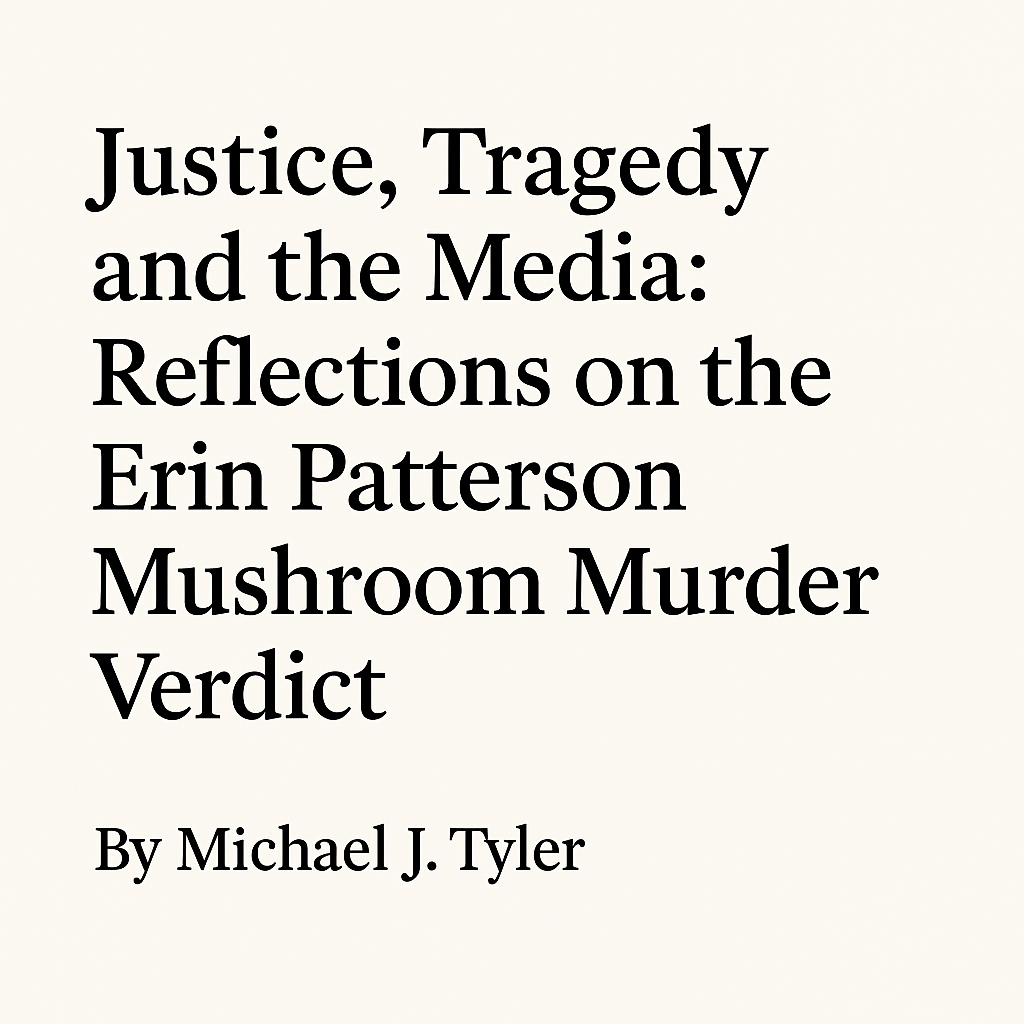
Justice, Tragedy and the Media: Reflections on the Erin Patterson Mushroom Murder Verdict
By Michael J. Tyler
A Lunch That Ended in Murder
It sounds like the plot of a crime novel – a quiet family lunch in country Victoria, a homemade beef Wellington, and a horrifying twist. But this was no work of fiction. This was the tragic reality in Leongatha, where three people died and a fourth was left fighting for life following what prosecutors described as a cold and calculated act of murder.
This week, the Supreme Court jury delivered its verdict: guilty.
Erin Patterson, 49, was found guilty of murdering her former in-laws, Don and Gail Patterson, and Gail’s sister Heather Wilkinson. Heather’s husband, Ian Wilkinson, survived the poisoning but endured a long hospital stay and extensive recovery.
The verdict came after a nine-week trial in Morwell and seven days of jury deliberation. It was one of the most high-profile criminal cases regional Victoria has seen in years.
A Case Built on Deception
The prosecution painted a disturbing picture of manipulation and premeditation. According to Crown Prosecutor Nanette Rogers SC, Erin Patterson carefully planned the fatal lunch and laced individual servings of beef Wellington with deadly death cap mushrooms.
She was accused of four major acts of deception. First, she allegedly faked a cancer diagnosis to lure her guests to lunch and ensure her own children weren’t present. Second, she is said to have prepared and served the contaminated beef Wellington in a way that ensured she wouldn’t ingest the poison herself. Third, she reportedly faked illness shortly after the meal to deflect suspicion. And fourth, the prosecution claimed she misled investigators by lying about the mushrooms’ origin, hiding her mobile phone, and disposing of a food dehydrator that was later recovered.
The court heard that Erin Patterson also attempted to poison her ex-husband on multiple occasions prior to this fatal lunch.
The jury, made up of seven men and five women, found that the evidence pointed clearly to deliberate intent.
In the Courtroom
Observers noted Erin Patterson showed little visible emotion when the verdict was read out. She remained composed, watching the courtroom proceedings in silence.
She has been remanded in custody and will face a plea hearing, where legal teams will make sentencing submissions before Justice Beale. Sentencing will be set for a later date.
Media Saturation and the Challenge of a Fair Trial
Few cases in recent memory have attracted as much media attention as this one. From the moment details of the “mushroom lunch” emerged, it became headline news. This intense coverage, while understandable, raises important questions about how we maintain fairness in criminal trials under the spotlight of public scrutiny.
In Australia, the presumption of innocence is a cornerstone of our legal system. Jurors are instructed to decide cases based solely on the evidence presented in court. But in high-profile cases, the risk of outside influence increases. With 24-hour news cycles, social media, podcasts and endless commentary, jurors can be exposed to information that may never be tested in court.
It is not uncommon for courts to warn jurors against researching cases or consuming related media. However, the challenge of separating fact from public opinion is significant, especially in smaller communities where media coverage is pervasive.
The Erin Patterson case highlights the fine balance courts must strike between open justice and protecting the integrity of a trial.
Legal Lessons from the Mushroom Murder Case
There are several key takeaways from this tragic and complex case.
First, it reinforces that convictions can be secured through circumstantial evidence, even in the absence of a confession or direct witness. In this trial, expert testimony, medical timelines and behavioural evidence were enough to establish guilt.
Second, it shows that premeditation can be proven through patterns and intent. The alleged prior attempts to poison her former partner, combined with the deliberate steps taken on the day of the lunch, painted a compelling picture for the jury.
Third, it underlines the role media plays in shaping public perception, and how courts must manage that influence carefully to ensure justice remains fair.
What Comes Next
Erin Patterson now awaits her plea hearing. Both the prosecution and defence will present arguments regarding her sentence. Given the gravity of the offences, a lengthy prison term is likely.
It remains to be seen whether she will appeal the verdict. In a case this complex, legal challenges post-trial are not uncommon, particularly given the media attention it has received.
Justice Served, but with a Heavy Heart
There is no joy in this outcome, only a sense of grim closure. Three lives were lost, a fourth forever changed, and the ripples of this crime will be felt by families and communities for years to come.
This case should be remembered not just for its tragic details, but for the broader lessons it offers about justice, media influence and the strength of the legal process.
Let us reflect not only on what happened that day in Leongatha, but on how we uphold fairness and truth in a time when every courtroom decision can become national news.
Michael J. Tyler
Principal Law Analylist | Legal Commentator | Advocate for Justice